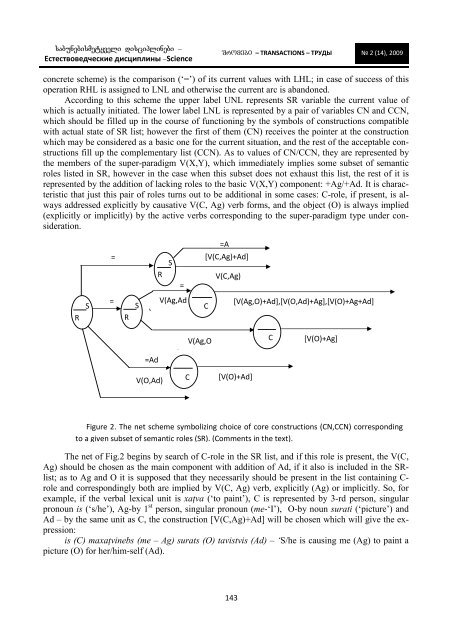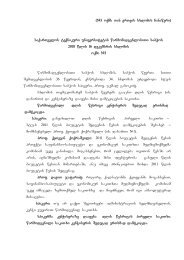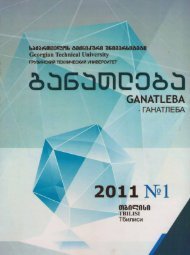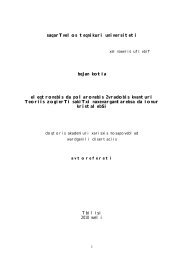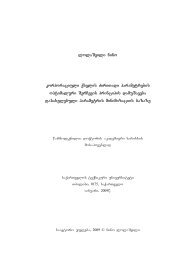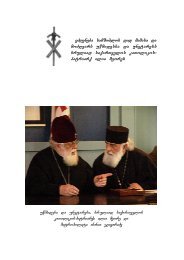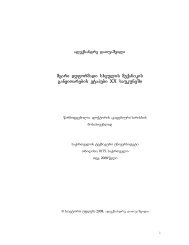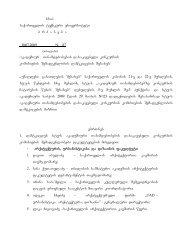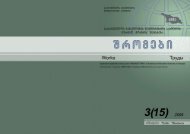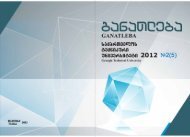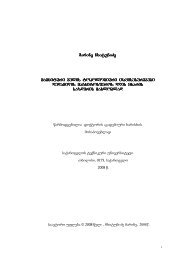№ 2 (<strong>14</strong>), 2009 <strong>Sromebi</strong> – TRANSACTIONS – ТРУДЫsabunebismetyveli disciplinebi –Естествоведческие дисциплины –ScienceC → Ag → O → (Ad) (4)The global picture of this (šeneba – ‘to build’) super-paradigm may be represented by sequence:ašenebinebs → (a/u šenebs → (/u) šenebdaC(C, Ag) → V(Ag, O/Ad) → V(O)/V(O, Ad) (5)Perhaps, it is useful to reproduce here the two-dimensional scheme given in [1] for the samesuper-paradigm, which most obviously mirrors the relations between members of the superparadigm,on the one hand, and their dependences in the subsets of semantic roles, on the otherhand (see Fig.1).We shall consider just this structure of a super-paradigm as a basic one and we shall try tosketch the syntactic interface based on this scheme, which subsumes many active verbs differentfrom šeneba (‘to build’): xaţva (‘to paint’), ķitxva (‘to read’), çera (‘to write’), ķeteba (‘todo/make’), etc. Of course, many other verbs (e.g. qepa – ‘to bark’, curva – ‘to swim’, siqvaruli – ‘tolove’, etc.) have the super-paradigm structures, which more or less deviate from the one acceptedby us as a basic one, at least some of this deviations and their influence on the structure of the interfaceitself will be considered and discussed later.aašenebina V(C,Ag)(‘caused to build’)aašena V(Ag,O)(‘built’)aušena V(Ag,Ad)(‘built for Ad’)ašenda V(O)(‘has beenaušenda V(O,Ad)(‘has been built for)AOAFigure1. Two‐dimensional picture of relations between members of a super‐paradigm(šeneba – ‘to build’) and semantic roles.As a first step towards construction of the syntactic interface (as yet scheme of Fig. 1 only)should serve the rules for the choice of a super-paradigm member which is in accordance with thegiven set of semantic roles. The constraints on this choice are of two mutually opposed kinds: thefirst of them are defined by the lack of some SR mentioned in the scheme of Fig. 1; the others dependon the subset of SRs which is actually initiated. Only the former are quite strict and decisive(if we ignore the elliptical expressions): for example, the causative construction V(C, Ag) may byno means be chosen, if the semantic role of Causer is lacking.However, the presence of some SRs in the actual subset sometimes does not exert such decisiveinfluence on the choice of the verbal unit: for example, the Ag semantic role does not requirenecessarily the choice of V(Ag, O), V(Ag, Ad) constructions which explicitly address it; the choiceof V(O) or V(O, Ad) is also acceptable in this case, because Ag may be included in this constructionsalso by some additional means (though without a direct address from the verb). An analogoussituation characterizes the Ad role which may be expressed (without explicit address) in constructionslike V(C, Ag), V(Ag, O), V(O).The scheme in Fig.2 is represented by the some kind of morphologic net (detailed descriptionof these nets is given in Van Valin & Lapolla, 1997). The only “novelty” is the possibility of doublelabeling of nodes: by Upper (UNL) and Lower (LNL) Node Labels; at the same time the values ofUNL variable are expressed by the Left-Hand Label of the arc (LHL), and those of LNL – by thecorresponding Right-Hand Label (RHL). The only operation for UNL (at least in the frame of this<strong>14</strong>2
sabunebismetyveli disciplinebi –Естествоведческие дисциплины –Science<strong>Sromebi</strong> – TRANSACTIONS – ТРУДЫ № 2 (<strong>14</strong>), 2009concrete scheme) is the comparison (‘=’) of its current values with LHL; in case of success of thisoperation RHL is assigned to LNL and otherwise the current arc is abandoned.According to this scheme the upper label UNL represents SR variable the current value ofwhich is actually initiated. The lower label LNL is represented by a pair of variables CN and CCN,which should be filled up in the course of functioning by the symbols of constructions compatiblewith actual state of SR list; however the first of them (CN) receives the pointer at the constructionwhich may be considered as a basic one for the current situation, and the rest of the acceptable constructionsfill up the complementary list (CCN). As to values of CN/CCN, they are represented bythe members of the super-paradigm V(X,Y), which immediately implies some subset of semanticroles listed in SR, however in the case when this subset does not exhaust this list, the rest of it isrepresented by the addition of lacking roles to the basic V(X,Y) component: +Ag/+Ad. It is characteristicthat just this pair of roles turns out to be additional in some cases: C-role, if present, is alwaysaddressed explicitly by causative V(C, Ag) verb forms, and the object (O) is always implied(explicitly or implicitly) by the active verbs corresponding to the super-paradigm type under consideration.=A=RS=[V(C,Ag)+Ad]V(C,Ag)RS=RS)V(Ag,AdC[V(Ag,O)+Ad],[V(O,Ad)+Ag],[V(O)+Ag+Ad]V(Ag,OC[V(O)+Ag]=Ad)V(O,Ad)C[V(O)+Ad]Figure 2. The net scheme symbolizing choice of core constructions (CN,CCN) correspondingto a given subset of semantic roles (SR). (Comments in the text).The net of Fig.2 begins by search of C-role in the SR list, and if this role is present, the V(C,Ag) should be chosen as the main component with addition of Ad, if it also is included in the SRlist;as to Ag and O it is supposed that they necessarily should be present in the list containing C-role and correspondingly both are implied by V(C, Ag) verb, explicitly (Ag) or implicitly. So, forexample, if the verbal lexical unit is xaţva (‘to paint’), C is represented by 3-rd person, singularpronoun is (‘s/he’), Ag-by 1 st person, singular pronoun (me-‘I’), O-by noun surati (‘picture’) andAd – by the same unit as C, the construction [V(C,Ag)+Ad] will be chosen which will give the expression:is (C) maxaţvinebs (me – Ag) surats (O) tavistvis (Ad) – ‘S/he is causing me (Ag) to paint apicture (O) for her/him-self (Ad).<strong>14</strong>3
- Page 1 and 2:
saqarTvelos ganaTlebis mecnierebaTa
- Page 3 and 4:
sarCevi/Оглавление/Conten
- Page 5 and 6:
pedagogika/Педагогика/Ped
- Page 7 and 8:
pedagogika/Педагогика/Ped
- Page 9 and 10:
pedagogika - Pedagogics - Педа
- Page 11 and 12:
pedagogika - Pedagogics - Педа
- Page 13 and 14:
pedagogika - Pedagogics - Педа
- Page 15 and 16:
pedagogika - Pedagogics - Педа
- Page 17 and 18:
pedagogika - Pedagogics - Педа
- Page 19 and 20:
pedagogika - Pedagogics - Педа
- Page 21 and 22:
pedagogika - Pedagogics - Педа
- Page 23 and 24:
filologia - Филология - Ph
- Page 25 and 26:
filologia - Филология - Ph
- Page 27 and 28:
filologia - Филология - Ph
- Page 29 and 30:
filologia - Филология - Ph
- Page 31 and 32:
filologia - Филология - Ph
- Page 33 and 34:
filologia - Филология - Ph
- Page 35 and 36:
filologia - Филология - Ph
- Page 37 and 38:
filologia - Филология - Ph
- Page 39 and 40:
filologia - Филология - Ph
- Page 41 and 42:
filologia - Филология - Ph
- Page 44 and 45:
№ 2 (14), 2009 Sromebi - TRANSACT
- Page 46 and 47:
№ 2 (14), 2009 Sromebi - TRANSACT
- Page 48 and 49:
№ 2 (14), 2009 Sromebi - TRANSACT
- Page 50 and 51:
№ 2 (14), 2009 Sromebi - TRANSACT
- Page 52 and 53:
№ 2 (14), 2009 Sromebi - TRANSACT
- Page 54 and 55:
№ 2 (14), 2009 Sromebi - TRANSACT
- Page 56 and 57:
№ 2 (14), 2009 Sromebi - TRANSACT
- Page 58 and 59:
№ 2 (14), 2009 Sromebi - TRANSACT
- Page 60 and 61:
№ 2 (14), 2009 Sromebi - TRANSACT
- Page 62 and 63:
№ 2 (14), 2009 Sromebi - TRANSACT
- Page 64 and 65:
№ 2 (14), 2009 Sromebi - TRANSACT
- Page 66 and 67:
№ 2 (14), 2009 Sromebi - TRANSACT
- Page 68 and 69:
№ 2 (14), 2009 Sromebi - TRANSACT
- Page 70 and 71:
№ 2 (14), 2009 Sromebi - TRANSACT
- Page 72 and 73:
№ 2 (14), 2009 Sromebi - TRANSACT
- Page 74 and 75:
№ 2 (14), 2009 Sromebi - TRANSACT
- Page 76 and 77:
№ 2 (14), 2009 Sromebi - TRANSACT
- Page 78 and 79:
№ 2 (14), 2009 Sromebi - TRANSACT
- Page 80 and 81:
№ 2 (14), 2009 Sromebi - TRANSACT
- Page 82 and 83:
№ 2 (14), 2009 Sromebi - TRANSACT
- Page 84 and 85:
№ 2 (14), 2009 Sromebi - TRANSACT
- Page 86 and 87:
№ 2 (14), 2009 Sromebi - TRANSACT
- Page 88 and 89:
№ 2 (14), 2009 Sromebi - TRANSACT
- Page 90 and 91:
№ 2 (14), 2009 Sromebi - TRANSACT
- Page 92 and 93: № 2 (14), 2009 Sromebi - TRANSACT
- Page 94 and 95: № 2 (14), 2009 Sromebi - TRANSACT
- Page 96 and 97: № 2 (14), 2009 Sromebi - TRANSACT
- Page 98 and 99: № 2 (14), 2009 Sromebi - TRANSACT
- Page 100 and 101: № 2 (14), 2009 Sromebi - TRANSACT
- Page 102 and 103: № 2 (14), 2009 Sromebi - TRANSACT
- Page 104 and 105: № 2 (14), 2009 Sromebi - TRANSACT
- Page 106 and 107: № 2 (14), 2009 Sromebi - TRANSACT
- Page 108 and 109: № 2 (14), 2009 Sromebi - TRANSACT
- Page 110 and 111: № 2 (14), 2009 Sromebi - TRANSACT
- Page 112 and 113: № 2 (14), 2009 Sromebi - TRANSACT
- Page 114 and 115: № 2 (14), 2009 Sromebi - TRANSACT
- Page 116 and 117: № 2 (14), 2009 Sromebi - TRANSACT
- Page 118 and 119: № 2 (14), 2009 Sromebi - TRANSACT
- Page 120 and 121: № 2 (14), 2009 Sromebi - TRANSACT
- Page 122 and 123: № 2 (14), 2009 Sromebi - TRANSACT
- Page 124 and 125: № 2 (14), 2009 Sromebi - TRANSACT
- Page 126 and 127: № 2 (14), 2009 Sromebi - TRANSACT
- Page 128 and 129: № 2 (14), 2009 Sromebi - TRANSACT
- Page 130 and 131: № 2 (14), 2009 Sromebi - TRANSACT
- Page 132 and 133: № 2 (14), 2009 Sromebi - TRANSACT
- Page 134 and 135: № 2 (14), 2009 Sromebi - TRANSACT
- Page 136 and 137: № 2 (14), 2009 Sromebi - TRANSACT
- Page 138 and 139: № 2 (14), 2009 Sromebi - TRANSACT
- Page 140 and 141: № 2 (14), 2009 Sromebi - TRANSACT
- Page 144 and 145: № 2 (14), 2009 Sromebi - TRANSACT
- Page 146 and 147: № 2 (14), 2009 Sromebi - TRANSACT
- Page 148 and 149: № 2 (14), 2009 Sromebi - TRANSACT
- Page 150 and 151: № 2 (14), 2009 Sromebi - TRANSACT
- Page 152 and 153: № 2 (14), 2009 Sromebi - TRANSACT
- Page 154 and 155: № 2 (14), 2009 Sromebi - TRANSACT
- Page 156 and 157: № 2 (14), 2009 Sromebi - TRANSACT
- Page 158 and 159: № 2 (14), 2009 Sromebi - TRANSACT
- Page 160 and 161: № 2 (14), 2009 Sromebi - TRANSACT
- Page 162 and 163: № 2 (14), 2009 Sromebi - TRANSACT
- Page 164 and 165: № 2 (14), 2009 Sromebi - TRANSACT
- Page 166 and 167: № 2 (14), 2009 Sromebi - TRANSACT
- Page 168 and 169: № 2 (14), 2009 Sromebi - TRANSACT
- Page 170 and 171: № 2 (14), 2009 Sromebi - TRANSACT
- Page 172 and 173: № 2 (14), 2009 Sromebi - TRANSACT
- Page 174 and 175: № 2 (14), 2009 Sromebi - TRANSACT
- Page 176 and 177: № 2 (14), 2009 Sromebi - TRANSACT
- Page 178 and 179: № 2 (14), 2009 Sromebi - TRANSACT
- Page 180 and 181: № 2 (14), 2009 Sromebi - TRANSACT
- Page 182 and 183: № 2 (14), 2009 Sromebi - TRANSACT
- Page 184 and 185: № 2 (14), 2009 Sromebi - TRANSACT
- Page 186 and 187: № 2 (14), 2009 Sromebi - TRANSACT
- Page 188 and 189: № 2 (14), 2009 Sromebi - TRANSACT
- Page 190 and 191: № 2 (14), 2009 Sromebi - TRANSACT
- Page 192 and 193:
№ 2 (14), 2009 Sromebi - TRANSACT
- Page 194 and 195:
№ 2 (14), 2009 Sromebi - TRANSACT
- Page 196 and 197:
№ 2 (14), 2009 Sromebi - TRANSACT
- Page 198 and 199:
№ 2 (14), 2009 Sromebi - TRANSACT
- Page 200 and 201:
№ 2 (14), 2009 Sromebi - TRANSACT
- Page 202 and 203:
The journal is issued under the dec


